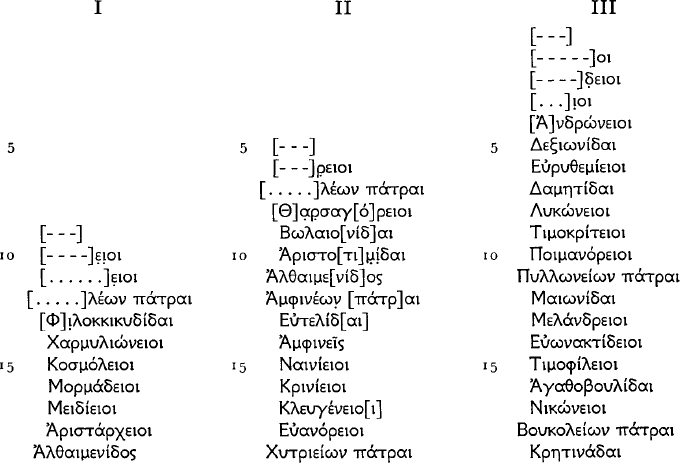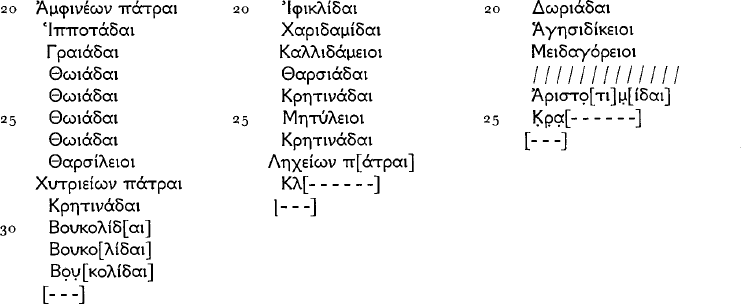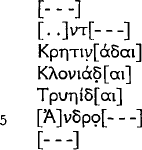Article contents
Extract
IG xii. 1. 695; T. Cam. 1. In the British Museum, from Kamiros. Early third century B.C.


Guarducci, Mem. dei Lincei vi. 8 (1938/9) 124, no. xxix bis; T. Cam. 2. Kamiros.

These lists present an organization at three levels:
(a) The smallest units are patrai, with names ending either -δαι or -ειοι, rather more of the latter than the former; the only exception is II 14 Ἀμφινεῖς.
(b) These are grouped under headings, Χυτριείων πάτραι (I 28, II 19), Βουκολείων πάτραι (III 18), &c. The general term for the bodies named Χυτρίειοι, &c., is not given.
(c) The heading Ἀλθαιμενίδος at I 19, II 11, embraces several of these second-level groups. At two removes above the patrai, Ἀλθαιμενίς must be a large body, something like a tribe, and the termination -ίς is common in tribe-names.
Among the puzzling features of the list is the repetition of certain names, either consecutively in the same group or from one group to another, thus:
⊖ωιάδαι: I 23–26 under Ἀμφινήων πάτραι.
Βουκολίδαι: I 30–32 under Χυτριείων.
Κρητινάδαι: I 29 under Χυτριείων; II 24, 26 under Χυτριείων; III 19 under Βουκολείων; T. Cam. 2. 2 in a different sequence with no heading preserved.
- Type
- Research Article
- Information
- Copyright
- Copyright © The Council, British School at Athens 1957
References
1 Tituli Camirenses, edd. Segre, and Carratelli, Pugliese, Annuario N.S. xi–xiii (1949–1951) 141 ff.Google Scholar, with a supplement, ibid. xiv–xvi (1952–4) 211 ff.
Recent discussions include: von Gaertringen, Hiller, RE suppl. v. 771 (1931)Google Scholar; Momigliano, A., Riv. Fil. lxiv (1936) 59–60Google Scholar; Guarducci, M., Mem. dei Lincei vi. 8 (1938/1939) 95 ffGoogle Scholar; Carratelli, G. Pugliese, Studi class. e orient. i (1951) 85–86Google Scholar. Earlier literature in Van Gelder, H., Geschichte der alten Rhodier (1900) 227.Google Scholar
This article could not have been written without the generous assistance of Mr. P. M. Fraser, who put at my disposal his collection of Rhodian material and patiently discussed the question with me. He would date the inscription to the earlier part of the third century, rather than to the fourth. I have also gained much from discussing with Mr. W. G. Forrest a parallel case at Chios to be published in a later volume of BSA.
2 But cf. Guarducci (see previous note) 97.
3 If they were a phratry, one would expect their subdivisions to be patrai with names of their own.
4 Γρεννάδαι are known as a Lindian patra, ibid. 391. 27, 392. a 10, b 13.
5 On the Dorian tribes at Rhodes, see Hiller, op. cit. 741; Momigliano 61; Carratelli, Pugliese, Parcla del Passato iv (1949) 154Google Scholar; and others. It is of course possible, though not specially probable, that the Ὑλλεῖς of Akragas were inherited from the Cretan colonists of Gela.
6 Fraser, , Eranos li (1953) 39–40.Google Scholar
7 With the publication of T. Cam. we can speak with more assurance about Kamiran demes; see Carratelli, Pugliese, Studi class. e orient. vi (1956) 62ff.Google Scholar
8 Cf. Guarducci, , Mem. dei Lincei vi. 6 (1937)Google Scholar 22–23.
9 Van Gelder, Hiller, and others maintain that the names in -ειοι are of Aeolic form. Apart from the general improbability of this (we should have to suppose that more than half the Kamirans of the third century exhibited this and only this Aeolic habit), it is to be noted that the Thessalians and others, though they use the adjective in -ειος, -αιος with individual names to indicate a man's father, turn to the ordinary Greek form in -δαι when they want a collective name for a family group, as Skopadai or Aleuadai in Thessaly, Penthilidai or Kleanaktidai in Mytilene.
10 The most illuminating discussion is by Wilamowitz, , Ar. u. Ath. ii. 180–5Google Scholar; cf. also Fraenkel, Ernst, RE xvi. 1636Google Scholar; I have not seen Ciardi-Dupré, Nota sui nomi greci in -δας (Florence, 1903). So many Mycenean names are now known that the absence of place-names in -δαι and personal names in -δας must be regarded as significant (Ventris, and Chadwick, , Documents 94Google Scholar, and the indexes). There are few collective names created between Πεισιστρατίδαι and Σελευκίδαι, and even these as ruling houses may be regarded as exceptional; conditions did not favour the creation of new and continuing family units. Βουσελιδῶν μνῆμα in [Dem.] xliii. 79 is an exception, but this family conspicuously did not hold together and neither Isaios xi nor [Dem.] uses Βουσελίδαι collectively for its fourth-century members. Comic formations like Ἑρμοκοπίδαι are another matter. It is to be noted that some early formations, e.g. Πραξιεργίδαι, can hardly be literally patronymic.
11 The Αἰάντειοι of the Lokrian maiden-inscription (third century: recent text of face A in Buck, , Greek Dialects (1955)Google Scholar, no. 60) are presumably an old formation. ![]() in an early inscription of Axos, now lost (IC ii. v. 9.12), might be the name of a hereditary group, cf. Guarducci ad loc.
in an early inscription of Axos, now lost (IC ii. v. 9.12), might be the name of a hereditary group, cf. Guarducci ad loc.
12 πυθαγορείοις in Herod, ii. 81. 2 is probably masculine (cf. Morrison, , CQ N.S. vi (1956) 136)Google Scholar and the earliest example; Βρασίδειοι, Thuc. v. 67. 1, &c. In these names the α of the stem is neglected, as in our inscription, whereas in Thessalian patronymic adjectives it is still regularly respected in hellenistic times, e.g. Buck no. 33 (Larisa, second century B.C.) ταγευόντων Χρίτουνος Παυσανιαίοι κτλ.
13 Cf. Carratelli, Pugliese, Annuario N.S. i–ii (1939–1940) 188–9Google Scholar, and the list of Rhodian associations, ibid. 176–86. The man who gave his name to the association sometimes appears beside it in the same inscription.
14 There was a group of some kind, probably not a patra, with the name Ἀμφινῖς at Troizen in the second century B.C. (IG iv. 757, B 29).
15 But not the commonest names of hellenistic Kamiros, see p. 36 below.
16 Βουκόλειοι might be connected with ancient pasturage-rights (see next paragraph, on synnomai): Χυτρίειοι sound more like potters. Occupational names of various kinds, together with a much larger number of names of other types, are found among the Attic gene and elsewhere. It is clear that no conclusion about the general character of such a system can be drawn from one or two of the names within it, disregarding the rest.
17 Carratelli, Pugliese, Studi (see n. 1) 86Google Scholar, objects that the two bodies would not be named side by side in this manner if one were a constituent of the other. If the text before us were the text of a decree passed (for example) by a single synnoma and one or more potrai, this would be a solid objection; but in a summary list of honours on a statue-base we may expect magniloquence rather than strict logic. The language links these bodies closely; it would be equally, or even more, appropriate if both were constituents of a larger whole, like γεννῆται and ὀργεῶνες within an Attic phratry; but this is not the situation which IG xii. 1. 695 presents. Since in fact we have here bodies of unknown name containing (so far as the evidence goes) only potrai, it is more economical to accept Jacopi's conjecture and call the larger bodies synnomai.
18 Diagoniai are discussed by several writers among those cited in n. 1, but only to note that the term is unknown elsewhere and evidently refers in some way to a connexion of kinship.
19 Blinkenberg restored ![]() but in view of the multiplicity of names in -δαι it seems better to leave this blank.
but in view of the multiplicity of names in -δαι it seems better to leave this blank.
20 The headings of II are 5–9 lines higher than the same headings in I. The discrepancy for III would be greater: in detail, if the heading Ληχείων πάτραι occupied the line above the first surviving line of III, it would be 27 lines above the same heading in II; if […‥]λέων πάτραι came immediately below the last line of III, the difference would be 18 lines between II and III, 13 between I and III. (In these counts, the erased line III 23 is not treated as a line.)
21 Eleven lines difference between II and III, and 19 between I and III; or 14 and 5 respectively.
22 But cf. the Τοττειδῶν δευτέρων of Chios (see n. 1 above).
23 The tribes of Kamiros, unlike those of Lindos, are made up of mainland as well as island demes (Fraser, l.c.), and the list of κτοῖναι whose inscription is ordered in IG xii. 1. 694 was to include those from the mainland.
24 The repeated names are sometimes consecutive (I 23–26) and sometimes not (II 24, 26), which might mean that the order in which the names were listed was significant for the purpose which the list served. (The Chian lists (n. 1) usually put the older names in -δαι at the top, which is not the case with the Kamiran synnomai.)
25 Ἀρίσταρχος for I 18, Κρίνις II 16 (the rarity of the name makes this interesting), Εὐάνωρ II 18, Λύκων III 8, Τιμόκριτος III 9, Νίκωι III 17.
26 I 16 Μορμάδειοι, I 17 Μειδίειοι, II 15 Ναινίειοι, II 25 Μητύλειοι.
27 At least thirty-five names in Ἀριστ-, with over 200 examples between them, but only four Ἀρίσταρχοι (and one Ἀριστότιμος, relevant if III 24 should read Ἀριστο[τί]μ[ειοι]). The many names in Τιμ- contain only one Τιμόκριτος (two Τιμάκριτοι), and the many in Ἁγησι- no Ἁγησίδικος: the only ![]() is
is ![]() (four examples), which is also the only Εὐρυ- name to help out III 6
(four examples), which is also the only Εὐρυ- name to help out III 6 ![]()
![]() Thirty-one names in
Thirty-one names in ![]() (over 100 examples) show no
(over 100 examples) show no ![]() or
or ![]() None of our patrai come from names beginning Δαμ- or ending
None of our patrai come from names beginning Δαμ- or ending ![]()
![]() which are common in T. Cam.
which are common in T. Cam.
28 Kedreai was not Rhodian in 404 (Xen. Hell. ii. 1. 15), nor perhaps earlier (Fraser and Bean 97); we do not know when it was acquired by Rhodes.
29 If the tribes were reformed in the fifth century, they will have needed some adjustment later, for a few small communities paying their tribute separately to Athens and therefore at that time somehow distinguishable units (ATL i. 513) were fully absorbed by the three cities later, after the synoecism: there would be no difficulty in adjusting the tribal system to include them.
- 1
- Cited by




